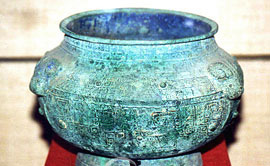| Legole.Com Discover china. Explore the beauty and wonder of the land, people, and culture of China. |
 |
|
|
 |
| |
| 16th - 11th century BC |
 The Shang was the second hereditary dynasty in China. It lasted almost six hundred years with thirty-one kings over seventeen generations. The Shang was the second hereditary dynasty in China. It lasted almost six hundred years with thirty-one kings over seventeen generations.
Shang used to be an old tribe lived in the lower reach of the Yellow River. It was a tributary of the Xia Kingdom. At the end of the Xia, the last ruler Jie was a tyrant who made his people live in misery. The chief of the Shang tribe, Tang, led an insurgent army and overthrew the Xia Dynasty (The 21st to the 17th century BC). Tang then established the Shang Dynasty and made Bo (present Caoxian County in Shandong Province) his capital city.
Political History
The Shang Dynasty was the second monarchical state in Chinese history. Tang, the founder of Shang, having drawn lessons from the ruin of the previous dynasty, treated his people benevolently and employed many able and virtuous ministers. The Shang made great progresses in its economy during the reign of Tang.
While, due to political struggle for power in the imperial court and continuous wars with frontier tribes, Shang state moved its capital five times. The most notable move was during the reign of King Pangeng, the seventeenth king of the Shang. He reestablished the capital at Yin, in the neighborhood of present Xiaotuncun, in Anyang City of Henan Province. The new capital contributed a lot to the stable government of the Shang Dynasty afterwards. Once the successful new capital was established, it did not change throughout the remainder of the Shang Dynasty. Therefore, the Shang Dynasty is often called "the Yin" or "the Yin-Shang Dynasty".
Another renowned Shang ruler was Wuding, the nephew of Pangeng. He was an aspirant and benevolent king and always endeavored to make his kingdom strong. Under his leadership, the empire of Shang made great achievements in its economy, which laid a foundation for the continuous development of following dynasties.
|
|
|
 |
|
